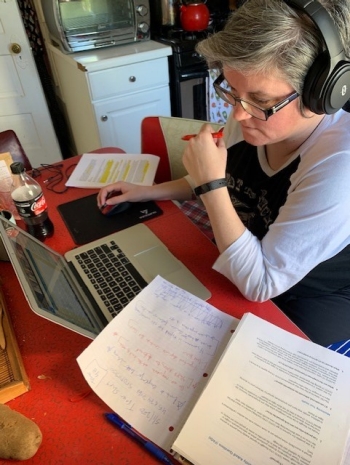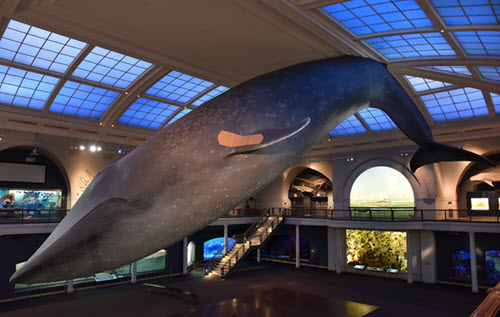A Year in the Life of a Librarian-Turned-Contact-Tracer

Before the pandemic, Lisa Fagundes was working as an adult services librarian in the Information Services Department of the San Francisco Public Library. Lisa’s role was essentially the first stop for patrons at the Main branch: fielding questions, answering general phone and email lines, and helping patrons navigate the immense, seven-story building. On March 16, 2020, the library closed its doors to the public, and one month later Lisa was deployed as a COVID-19 contact tracer for the City.
We caught up with Lisa to ask her about her experience over the past year -- the highs, the lows, the unexpected, and the outcomes. The following are excerpts from our interview, edited for length and clarity
How were you enlisted to be a contact tracer?
When the Library shut its doors, the City of San Francisco started deploying library staff as Disaster Service Workers. This is a contract that we sign as employees when we’re hired; in the event of a disaster, city employees may be called upon to help the City through a crisis.
Since the pandemic is a virus that is primarily spread through contact with other humans, I was very concerned about where I was going to be deployed. Some folks were working in hostels and food banks. I didn’t want to work outside of my home, as my partner is immunocompromised. My union alerted me to work-from-home contact tracing positions, and I immediately signed up.
(A big shout out to my union, Local 1021. Most of the information I received during this uncertain period came through them. Before the pandemic, our union meetings were small affairs, and during the pandemic we averaged hundreds of attendees at the virtual meetings. Staff were just so desperate for answers and information, and they really helped us out.)
How were you trained and who were you working with?
The training was extensive. We were trained by the Global Health Initiative Department of University of California San Francisco and spent a full week brushing up on COVID-19 information, HIPPA laws, interviewing techniques, and technology, and we listened to mock interviews and shadowed live calls. We also went over cultural humility and how to be an empathetic tracer. I felt very prepared to make my first call. There were a lot of library staff on the tracing team - I think at the peak we had about 300 tracers - but we also worked with many other City workers, including staff from the City Attorney's Office, the Tax Assessor, Health and Human Services, and the Department of Public Health. Eventually they added people from local community-based organizations and some State of California workers. It was truly a city-wide effort!
What did contact tracing involve?
I would start by receiving an email with a video conferencing invite to join a four-hour tracer shift. The shifts included a team lead and a clinician. We would meet virtually, and the team lead would go over updates, changes, and answer questions. Then the team lead would assign out contacts and I’d log off the video meeting and start making my calls.
The team leads were available to video chat or message and email throughout our shifts. The clinicians were also available to message when a contact had more clinical questions. At 15 minutes before the end of the shift we would all meet again in the video room for a debrief session. The team lead would ask for any follow up tasks our contacts needed and ask how our calls went. It was often a very useful session for sharing tips and decompressing after tough calls.
What were some memorable moments of contact tracing?
The hardest call I had to make was to a man living in a hospice facility for AIDS patients. His health was poor, and I was devasted to have to tell him that he was exposed to COVID, especially knowing what he was already suffering with.
I had many calls that ended up being very pleasant. I really enjoyed making my contacts feel comfortable and assuaging their fears as much as I was able to. Most contacts were just so happy someone from the city cared enough to call and alert them.
What were the challenges of contact tracing
Changes. Changes occurred every single day, sometimes hourly. There was always new science about the virus surfacing and new directives from either the CDC, the California Department of Public Health, or the San Francisco Department of Public Health. We had to stay on top of it all. The work was also often very emotional and difficult. Many times, contacts didn't have enough money to miss work for the 14 days of quarantine, and some people were just so incredibly scared of contracting the virus. All that fear came out during the calls.
I eventually became a team lead, and while I was no longer experiencing the emotional turmoil of being on the other end of the calls, I was dealing with the tracer's emotional troubles. Sometimes multiple tracers would break down during shifts because they'd had a tough call and needed a break.
The pandemic has been especially challenging for the Latinx and Black communities, which were much harder hit than other communities in San Francisco. Seeing the harsh inequities of our society laid bare during the pandemic was intense. How do you soothe a Latinx mom who is being told she can't go to work for the next 14 days and therefore will probably lose her job and possibly not be able to feed her kids? It was horrible to listen to people try to choose between their physical health and their economic reality.

What did you enjoy about contact tracing?
I loved working with all the people from the public health world, especially the UCSF crew. I've always been interested in medicine but didn't know much about the field of public health. They are such dedicated people - their work is so unheralded. I felt very proud to be part of the team.
Did the experience affect the way you think about librarians? If so, how?
(Laughs) I discovered that librarians ask a lot of questions and are good at picking apart what doesn't work well with systems/databases/standard operating procedures. The library staff on the tracing team were always the ones pushing the UCSF team to fix things and make systems more efficient. We were brutal in our database critiques! Librarians gonna librarian.
What is it like being back at work?
It was a tough transition for me. The library isn't fully functioning the way it was before the pandemic; we have less staff and more restrictions. I had to relearn my job, plus learn all the changes that happened during the 14 months I was out. We have a lot of vacancies from people who retired, moved, or switched careers, and we still have vacancies from staff who are deployed. Some staff are still working reduced schedules or partially from home, so we just don't have as many frontline workers as we used to.
What do you see as being important longer-term changes for the library?
I really hope that we use the pandemic as a chance to shake things up and continue to improve our systems for the better. I’m advocating for more flexible and equitable schedules, and for the sharing of frontline work. We should also incorporate more wellness activities for staff; our job is hard and frequently traumatic, and that could be directly addressed more.
Has the pandemic affected the way you now look at your job as a librarian?
I’d love to see the library and the Department of Public Health work together and partner more; libraries are a natural space to give out public health information. We can be centralized hubs for disseminating important information for the Department of Public Health, which doesn't really have a public space outside of medical settings. I think that is a rich vein we can explore as a city, and I’d love to be involved in that endeavor.
On a more difficult note, I became aware of how many hours I had been working at the library -- nine hour shifts without much flexibility. There’s not a lot of time to recharge or decompress during our workdays. I wish we all had more time to slow down a bit. If frontline staff are empowered and given time to recharge, that will be reflected in our interactions with the public. We need to value frontline staff more in our public libraries.
The collective trauma of this past year is so overwhelming for me to think about. I see so much opportunity for change, not just for me personally, or for my public library, but for my city, my state, my country, and the world. I sincerely hope we can all start shifting our priorities and really take this time to reflect and fix at least some of the glaring inequalities and inequities of our society. Life is short! Let's treat each other better.
Related stories
Libraries and Museums as Vaccination Sites
Libraries and museums are innovative community centers, and throughout the COVID-19 pandemic, they have been essential to the community and national response.
Want to learn more?
More resources are available through the REALM project website.
This project was made possible in part by the Institute of Museum and Library Services, project number: ODIS-246644-ODIS-20.

